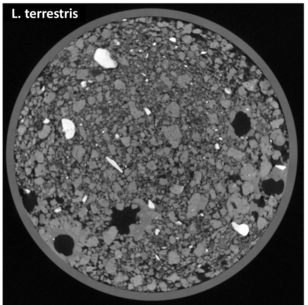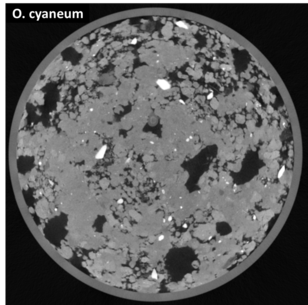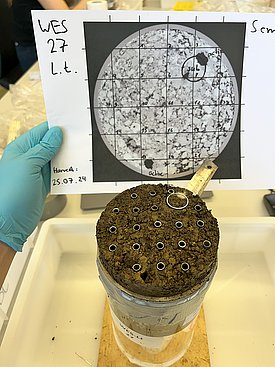05.12.2024 | Beate Kittl | WSL News
Earthworms are the “master builders” of the soil. They make nutrients available and sequester the greenhouse gas CO2 in the form of leaves in deep soil layers. A Swiss-German research team is investigating their work in Rendzina soils, the Swiss soil of the year 2025, which was chosen by the Swiss Soil Science Society on Soil Day, December 5.
New publication! Global change affects plants and soil organisms differently (see box below)
Rendzina, the Swiss soil of the year 2025, is typical of forests and meadows in the calcareous Jura. Hordes of earthworms burrow and rummage through it, which is why the rendzina has a thin but humus-rich topsoil. The burrowing of the worms mobilizes nutrients for other living organisms, and by pulling leaves into the soil, they store the greenhouse gas CO2 - which is incorporated as carbon in the leaves - in the soil humus. This important role of the worms is at risk, as climate change is expected to bring more frequent and longer dry periods. “Earthworms are more sensitive to this than fungi or microorganisms,” explains Frank Hagedorn, soil researcher at WSL.
As they work behind the scenes, little is known about how these charismatic soil architects influence the forest floor and its carbon flows. This is now being investigated by the Swiss-German research project Forest Floor. For his doctoral thesis at the Swiss Federal Institute for Forest, Snow and Landscape Research WSL, Philipp de Jong filled Rendzina soil from the Swiss Jura into plastic tubes and placed two species of earthworms inside. He fed them with foliage that was marked with isotopes and whose atomic composition (isotopes) thus differed from normal foliage.
Earthworms «dispose» of CO2 ¶
De Jong shed light on the underground workings of earthworms with X-ray images of the plastic tubes. Depending on the species, the worms dig either vertically or horizontally. The widespread commom earthworm (Lumbricus terrestris) forms vertical tunnels, pulls leaves into the depths, eats and digests them. However, it only inhabits a small part of the soil. The horizontally burrowing, blue-grey worm (Octolasion cyaneum), on the other hand, digs through the entire soil space, eating only soil and the microorganisms that live in it. Both species often occur together in nature. De Jong suspects that they store the most carbon in the soil when they work together.
To test this, de Jong measured the CO2 produced by the worms and other organisms in the soil. He found the labeled atoms of the foliage in the CO2 and was thus able to calculate a net balance of the converted carbon. The results show that less of the carbon from the foliage goes back into the atmosphere when both worm species live together. The next step is to find out where exactly the earthworms move the carbon to, how they protect it from further decomposition and how much carbon they store in the soil as a result. “This is important because soils store more carbon than the biomass living above ground, that is, the plants in the forest," says de Jong.
Rocky soil
The term rendzina comes from the Polish and describes the scratching that loose stones produce when plowing fields. Rendzina soils are typical of many regions in the Jura and the Limestone Alps. What makes them special is that they can store a lot of carbon, up to 400 tons per hectare. Depending on how much water is available at a location, common beeches, various types of oak and hornbeams grow on it. There is not much to be gained agriculturally on rendzina, which is why it is mostly used for grazing cattle outside the forest. (More about the soil of the year: boden-des-jahres.ch
Global change affects plants and soil organisms differently
A new study published in Nature Communications shows a surprising decoupling of the responses of plants and soil organisms to global change: while global environmental changes typically increase plant biomass, the diversity of plant species decreases. Soil organisms, on the other hand, react inconsistently and less predictably. These non-synchronous responses make it clear that changes in above-ground vegetation are not directly indicative of below-ground processes.
The study emphasizes the importance of including both above- and below-ground ecosystem components in environmental analyses. Approaches that focus only on visible, above-ground processes, such as those used to analyze satellite data, cannot fully capture the complexity of the entire ecosystem.
The researchers analyzed over 13,000 observations worldwide to investigate how factors such as global warming, increased CO2 levels, nitrogen deposition and changing precipitation patterns affect plants and soil organisms.
Publication: Yu, Q., et al. (2024). Decoupled responses of plants and soil biota to global change across the world's land ecosystems. Nature Communications, 15(1). https://doi.org/10.1038/s41467-024-54304-z
Contact: Arthur Gessler, Maihe Li
Publication ¶
Guidi C, Frey B, Brunner I, Meusburger K, Vogel ME, Chen X, Stucky T, Gwiazdowicz DJ, Skubała P, Bose AK, Schaub M, Rigling A, Hagedorn F (2022) Soil fauna drives vertical redistribution of soil organic carbon in a long-term irrigated dry pine forest. Global Change Biology. DOI: https://doi.org/10.1111/gcb.16122
Kontakt ¶
Copyright ¶
WSL and SLF provide image and sound material free of charge for use in the context of press contributions in connection with this media release. The transfer of this material to image, sound and/or video databases and the sale of the material by third parties are not permitted.








